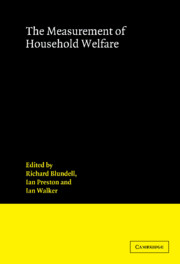Book contents
- Frontmatter
- Contents
- List of contributors
- 1 An introduction to applied welfare analysis
- 2 Measuring the cost of children: a theoretical framework
- 3 The collective approach to household behaviour
- 4 Ordinal and cardinal utility: an integration of the two dimensions of the welfare concept
- 5 The determination of welfare in nonintact families
- 6 Female labour supply, housework and family welfare
- 7 Engel equivalence scales in Sri Lanka: exactness, specification, measurement error
- 8 Measuring the life-cycle consumption costs of children
- 9 Family fortunes in the 1970s and 1980s
- 10 Ethically-consistent welfare prescriptions are reference price-independent
- 11 The effect of systematic misperception of income on the subjective poverty line
- Index of names
- Index of subjects
7 - Engel equivalence scales in Sri Lanka: exactness, specification, measurement error
Published online by Cambridge University Press: 13 January 2010
- Frontmatter
- Contents
- List of contributors
- 1 An introduction to applied welfare analysis
- 2 Measuring the cost of children: a theoretical framework
- 3 The collective approach to household behaviour
- 4 Ordinal and cardinal utility: an integration of the two dimensions of the welfare concept
- 5 The determination of welfare in nonintact families
- 6 Female labour supply, housework and family welfare
- 7 Engel equivalence scales in Sri Lanka: exactness, specification, measurement error
- 8 Measuring the life-cycle consumption costs of children
- 9 Family fortunes in the 1970s and 1980s
- 10 Ethically-consistent welfare prescriptions are reference price-independent
- 11 The effect of systematic misperception of income on the subjective poverty line
- Index of names
- Index of subjects
Summary
Introduction
Equivalence scales – index numbers that attempt to measure the cost to a household of a change in its composition – are of considerable importance in the study of poverty and distribution and in the formulation of government policy. Yet there appears to be no consensus on what model of equivalence scales is the most appropriate, or whether, if at all, comparisons of household welfare can be based on household expenditure data. The reader is referred to Coulter, Cowell and Jenkins (1991) and Browning (1991) for recent surveys of the literature.
The model of equivalence scales usually attributed to Engel (1857) is perhaps the simplest and most easy to compute. It relies on the use of the share of food, sometimes broadly interpreted to include other necessities, as an indicator of household welfare. The equivalence scale is simply the ratio of expenditures that imply equal levels of the budget share of food for households of different demographic compositions. In general, it is impossible to test the assumption used to identify household welfare from household behaviour; it is only possible to test the implications for household demand of an identifying assumption. This makes rejections conclusive, but not acceptances.
The restriction on household demand implied by the Engel model have been explicitly spelled out by Deaton (1981) and, more recently, Browning (1988) and Blackorby and Donaldson (1988). In the absence of information on price variation it is not possible in this chapter to test these restrictions explicitly.
- Type
- Chapter
- Information
- The Measurement of Household Welfare , pp. 164 - 191Publisher: Cambridge University PressPrint publication year: 1994
- 4
- Cited by



